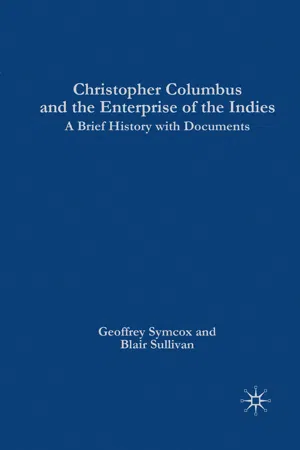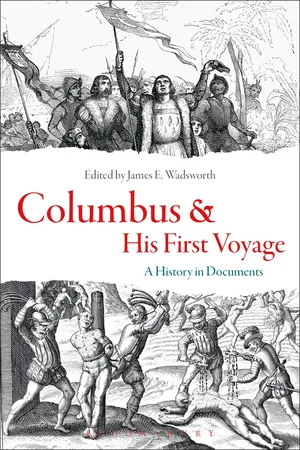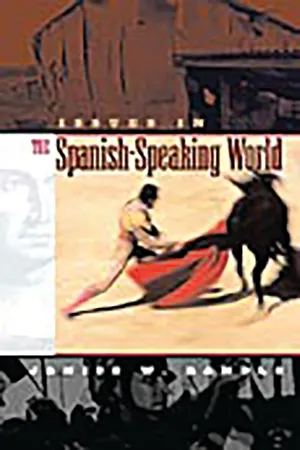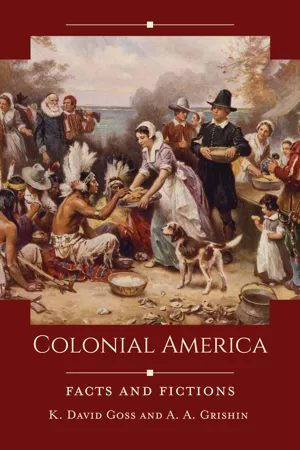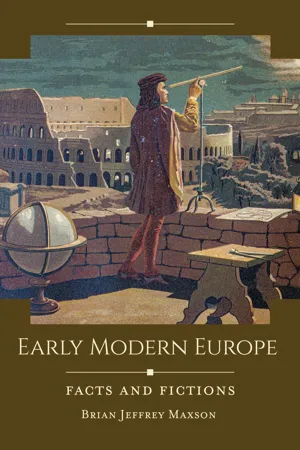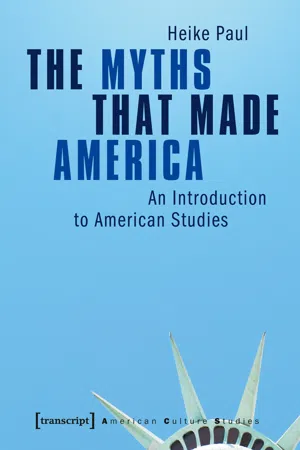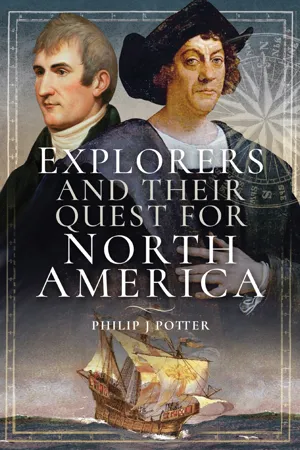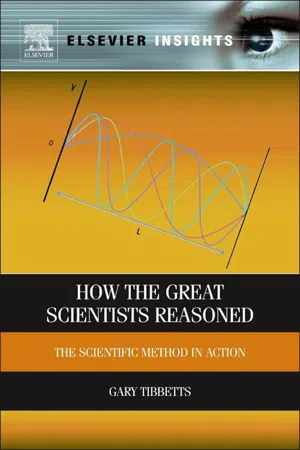History
Christopher Columbus
Christopher Columbus was an Italian explorer who completed four voyages across the Atlantic Ocean, opening the way for widespread European exploration and the eventual colonization of the Americas. His first voyage in 1492 led to the discovery of the New World, although he mistakenly believed he had reached Asia. Columbus's expeditions had a profound and lasting impact on global history.
Written by Perlego with AI-assistance
Related key terms
1 of 5
8 Key excerpts on "Christopher Columbus"
- eBook - PDF
Christopher Columbus and the Enterprise of the Indies
A Brief History with Documents
- NA NA(Author)
- 2016(Publication Date)
- Palgrave Macmillan(Publisher)
PART ONE Introduction: Columbus- The Man, the Voyages, the Legacy We have all heard of Christopher Columbus. Everyone knows that he led three small Spanish ships across the Atlantic in 1492 and reached the West Indies. October 12, the date of his landing there, is cele- brated as a holiday in the United States, where he ranks as a national hero on a par with the most revered presidents and civic leaders. Although he is famous throughout Europe and Latin America, only in the United States is he accorded special honor as one of the nation's founders: Every schoolchild there is taught the date of his voyage and the names of his ships. But the significance of his voyage resonates far beyond the United States: It was a decisive turning point in the his- tory of the entire world. It represented the real start of European colo- nization in the Americas; the earlier Viking settlements in North America had quickly withered away. The voyage completely changed European notions of geography and confronted Europeans with a host of alien peoples and cultures, forcing them to reappraise their notions of what constituted a civilized society. It marked the most critical moment in European overseas expansion, for it united Eurasia, Africa, and the Americas in a single world system for the first time, inaugu- rating the global era in which we live today. Columbus's intrepid voy- age across uncharted seas, and the momentous consequences that flowed from it, have made him a historic figure of mythic proportions. 1 2 INTRODUCriON Yet, a closer look soon reveals that Columbus is a far more com- plex, ambiguous, and controversial figure than the heroic icon made familiar in the United States by school textbooks, films, national holi- days, and popular song. It is important to remember that perceptions of him have shifted over time, and that they continue to change. - eBook - PDF
Columbus and His First Voyage
A History in Documents
- James E. Wadsworth(Author)
- 2016(Publication Date)
- Bloomsbury Academic(Publisher)
1 Columbus: The Man of Myth, the Man of History As a student of history and of Christopher Columbus, you may have found yourself swamped in the mire of competing opinions and viscerally emotional debates—many of which remain uninformed by authentic historical documentation. Perhaps this is truest for Columbus’s first voyage that long ago left the oceans of history to sail in the ethereal realms of myth. Everyone knows what happened. Of course they do. Or do they? At some point in your education you have most likely met the heroified Christopher Columbus. He is often portrayed as the restless genius who thought great thoughts and did great deeds almost single-handedly and was subsequently unjustly treated and died as a pauper. You have almost certainly heard of the flat earth theory in which Columbus conceived of a spherical earth that could be circumnavigated while the rest of the world believed it was flat. You have also probably heard of the restless crew who could only be pacified by Columbus’s charismatic leadership. You may even have heard that Queen Isabel was so infatuated with Columbus’s towering intellect and manly courage that she pawned the crown jewels to fund the voyage. And you may also have encountered the idea that the native peoples of what we now call the Americas were so overwhelmed by the majesty of Columbus and his ships that they accepted him as a god come from heaven and submitted to his superior intellect, technology, culture, and religion. Since the 1970s, and more intensely, during the 1992 quincentennial celebrations of Columbus’s first voyage, cracks and holes have been punched, sometimes ruthlessly, in these myths. They no longer shine so brightly— tarnished now by the memory of the horrific and earth-transforming events that voyage set in motion. 1 Whatever you might think of Columbus, it Columbus and His First Voyage 2 cannot be denied that that first voyage left the world irrevocably changed. - eBook - PDF
- Janice Randle(Author)
- 2003(Publication Date)
- Greenwood(Publisher)
Eventually he returned to Spain, where he made repeated unsuccessful requests to the king for the portion due to him from the discoveries he had made. Columbus died, still believing he had explored the outer fringes of the Indies— or China, or Japan—in 1506. The voyages of Columbus opened a new chapter in the history of the world, a period of exploration that would eventually bring to light two new continents and a new ocean, millions of human beings whose existence was undreamed of, a flood of silver and gold, and oddities such as rubber, tobacco, cocoa and chicle (the tree sap from which chewing gum is made). Valuable new edible plants from the Americas, such as potatoes, tomatoes, chiles and corn, would trans- form the diet of people not only in Europe but also around the world. 10 For all this he has been hailed as a visionary and per- haps the greatest explorer of all time. Should he also be blamed for the hundreds of years of exploitation and discrimination that his expeditions inaugurated in the New World? Should the descendants of indigenous and African peoples blame him for the enslave- ment of their ancestors? Let's look at some of the questions in this debate: 1. Should Christopher Columbus get the credit for "discovering" the New World? 2. Did Columbus set the pattern for a program of genocide in the New World? Columbus and the "New" World 51 3. Should we celebrate the "discovery" of the New World, knowing that it also cut short forever the autonomous development of the pre- Columbian world? DISCUSSION Should Christopher Columbus Get the Credit for "Discovering" the New World? Agree Leaving aside the question of whether or not one can "discover" a hemisphere already inhabited by 50 to 90 million people, most modern scholars accept the fact that Columbus was the first Euro- pean to cross the ocean, land in the New World, return and make the news well known. - eBook - ePub
Colonial America
Facts and Fictions
- K. David Goss, A. A. Grishin(Authors)
- 2021(Publication Date)
- ABC-CLIO(Publisher)
Certainly, no doubt can be placed upon the clear anthropological evidence of several Ice Age migrations of Asian tribes moving into North America across the land bridge that once joined eastern Siberia to present-day Alaska. More recent research has even speculated that the Western Hemisphere was visited by prehistoric European people who crossed from Northern Europe along the perimeter of an ice bridge that once connected Northern Europe to North America during the last Ice Age, over ten thousand years ago. And early modern historians have had no difficulty believing that the Atlantic Ocean might well have been traversed by ships blown off course from ancient times to the Middle Ages. More recent authors have furnished research of varying value suggesting that the New World was discovered and explored prior to Columbus by Chinese navigators and even the Knights Templar fleeing persecution in Europe.And yet, when one is asked who should properly be called the discoverer of America, the name Christopher Columbus will almost always come up—if not right away then after some deliberation. He is generally considered the first European to claim areas of the Western Hemisphere for a European nation and to have first established a marginal foothold in the New World that would eventually grow to become a massive colonial empire in the name of the Spanish crown. In recent years, Columbus’s reputation as an enslaver of human beings and an exploiter of native peoples has cast a dark shadow on his name, but despite these moral failings, his title as the “Discoverer of the New World” has not, as yet, been stripped away. And this is because every history text that includes the period known as the Age of Exploration and Discovery provides at least a summary of Columbus’s struggles and achievements, usually concluding with the point that although he was persuaded he had reached islands off the coast of Asia, he had in fact discovered the Western Hemisphere. Some authors go so far as to suggest that Columbus was responsible for demonstrating conclusively for the first time that Earth is indeed round. - eBook - ePub
Early Modern Europe
Facts and Fictions
- Brian Jeffrey Maxson(Author)
- 2023(Publication Date)
- Bloomsbury Academic(Publisher)
After several weeks at sea, Columbus arrived in the Caribbean. He believed that he had arrived on the eastern coast of Asia and immediately began searching for gold and the fabled kingdom of Japan. Through gestures, he established trade with local Amerindians, who at first seemed puzzled by Columbus’s arrival. Confusion between the two peoples quickly deteriorated into violence and disaster. Columbus enslaved people to return them to Spain. He incessantly demanded that people tell him where to find precious metals, and soon, people began giving him answers to get rid of him or to avoid him. Soon after, Columbus began to arrive in empty villages. Columbus’s firsthand accounts of his voyages reveal a man who was obsessed with his role in a divine plan. He was also driven by economic motives. He repeatedly noted that the peoples he found would be easy for his sovereigns to conquer. Far from being sparsely populated, the Caribbean encountered by Columbus was full of people with different cultures and different languages. Columbus returned to Spain and was granted titles and honors for his successes. He died believing that he had found a passage to Asia.Columbus left behind a legacy that was controversial in his own day and that remains so. Columbus himself and then many individuals after him established systems of exploitation and enslavement that decimated Amerindian populations. In the early sixteenth century, people already questioned the morality of what was happening. Some argued that the conquests were legitimate and a necessary expansion of Christianity to new peoples. Others, however, condemned the despicable treatment of Amerindians and worried that it would bring down the wrath of God and then the end of the Spanish empire. Forced Amerindian labor, gold, and silver helped finance wars in Europe over the Italian peninsula and religion during the sixteenth, seventeenth, and later centuries. Disease—both intentionally and unintentionally spread—ravaged Amerindian populations. New diseases also entered Europe. Millions of Amerindians were enslaved or slaughtered. Certainly, the battles between Amerindians and Europeans were rarely one-sided. Early conquerors found successes largely through the assistance of Amerindian allies. But the ultimate result was the conquest of two continents and then a myth about a protagonist who fought the ignorance of his own day and discovered largely uninhabited lands.PRIMARY SOURCE DOCUMENTSPaolo Toscanelli was a learned man based in Florence, Italy. He was interested in the ongoing explorations of the Atlantic Ocean during the 1400s. He wrote a letter to Portugal in which he advised that the king consider sailing to the west in order to reach the riches of the Spice Islands. Toscanelli incorrectly argued that the world was much smaller than most previous thinkers had thought. Columbus ran with Toscanelli’s miscalculation. In the following excerpt, Toscanelli sends a copy of a document to Columbus. Note what Toscanelli views as important about sailing west, what sorts of things he sees as novel, and what sorts of things he takes for granted. - eBook - PDF
The Myths That Made America
An Introduction to American Studies
- Heike Paul(Author)
- 2014(Publication Date)
- transcript Verlag(Publisher)
It is in the last decades of the 18 th century that the specifically North American myth of Columbus comes into existence and in a very brief time span is firmly consolidated and embroidered. In the process of transmission from Spanish-language to English-language sources, William Robertson’s 1778 Histo-ry of America is highly influential – this book “was available to more American colonists than was any earlier source” (Bushman, America 40) and devoted hundreds of pages to Columbus, who, according to Robertson, in his endeavors combined “the superiority of genius” with “ardent enthusiasm” ( History Vol. II 104). Robertson follows de las Casas in elevating Columbus and in crediting him with the ‘discovery’ of a new world. Overall, the author blames the Spanish col-onizers (aside from Columbus) for their violent excesses in Latin America, but unsurprisingly exempts the British colonial power exercising control in North America from any criticism. In the context of the American anti-colonial movement directed against the British Crown shortly before, during, and particularly after the American Revo-lutionary War (1775-1783), the cultural work of American public intellectuals, C HRISTOPHER C OLUMBUS AND THE M YTH OF ‘D ISCOVERY ’ | 53 writers and poets was to colonize the past in order to invent a meaningful be-ginning, and they did so by making the figure of Columbus part of their own colonial and postcolonial legacy. Many public figures and writers gathered around Columbus as a historical persona to affirm North American indepen-dence, and they represented him as a figure of national consensus exemplifying American national virtues and an American national character avant la lettre (cf. Herget, “Whitewashing” 3). - eBook - ePub
- Philip J. Potter(Author)
- 2020(Publication Date)
- Pen & Sword History(Publisher)
Christopher ColumbusIn April 1492, Christopher Columbus was issued a charter by the Spanish crown for an expedition to reach the riches of China by sailing to the west. After recruiting his crews and preparing his fleet, on 3 August 1492 his small ships departed from the port of Palos in south-west Spain, heading into unknown seas that many Europeans believed were occupied by horrible monsters. By early October, the crewmen on Columbus’ vessels had been out of sight of the land for over twenty days and were growing increasingly mutinous. As the seamen talked of turning back to Spain, on 7 October large flocks of birds were seen flying overhead. Encouraged by the sightings of the birds, Columbus altered his western course, steering his ships south-west. The trade winds blew stronger two days later, and there were the first signs of land when the sailors spotted tree branches with green leaves. The Spanish flotilla ploughed forward into the pitching deep blue ocean. On 11 October, the sun set on a clear horizon and the night was cloudless, with a late rising moon. As the lookouts high in the riggings strained their eyes into the golden light of the moon, around two in the morning, Rodrigo de Triana onboard the Pinta shouted out, ‘Land, land’. In the morning, the white beach was clearly visible and Columbus went ashore in the early afternoon, naming the island in the Bahama chain San Salvador to ignite the age of discovery and exploration in the New World.Christopher Columbus was born in the independent Italian Republic of Genoa in the second half of 1451, the first son of Domenico and Susanna Fontanarossa Columbus. He was raised in a middle class tradesman’s family with his three younger brothers and one sister. Domenico was a master weaver and owned a prosperous wool business in Genoa. He was a member of the local weaver’s guild and was active in the city’s politics. In recognition of his political loyalty, Domenico was appointed warden for the Porta dell Olivella Gate. Christopher received little if any formal education and was occupied working in his father’s shop as a weaver. As a Genoese boy living on the coast of the Mediterranean, he had frequent contacts with sailors, ships’ captains and travellers from foreign lands, and was drawn to the sea. Around age 10, Columbus began making short voyages close to Genoa, while continuing to work in the family’s weaving business. Several years later, he started taking longer journeys, gaining an education and experience in seamanship and navigation. In 1470, when King Rene II of Anjou hired a mercenary fleet for his war against John II, king of Aragon, Columbus served as a seaman on a Genoese warship taking part in a brief naval battle against the Spanish. - eBook - ePub
How the Great Scientists Reasoned
The Scientific Method in Action
- Gary G. Tibbetts(Author)
- 2012(Publication Date)
- Elsevier(Publisher)
3
Christopher Columbus and the Discovery of the “Indies”It Can Be Disastrous to Stubbornly Refuse to Recognize That You Have Falsified Your Own Hypothesis
A working hypothesis is frequently not much better than a guess, but it is a guess that should be altered and improved as new and germane data are acquired. We will see how Christopher Columbus sought financial support for his voyage to “the Indies” with a deeply flawed hypothesis vastly underestimating the length of such a voyage. There was no room in Columbus’s hypothesis for new continents, and he would not settle for such an outcome. Columbus stubbornly went to his grave insisting that the Caribbean islands he discovered on his first voyage were the Indies, even though his four voyages had developed persuasive evidence that he had discovered completely new territories not part of the Indies, Japan, or Asia.Nevertheless, Columbus was a giant of exploration, and he must be credited with “discovering” an area of the globe unknown to European or Asian civilization. His inaccurate hypothesis propelled him not to Asia but to rich islands and Central and South America. The careful preparations he had made for proposing his “enterprise of the Indies” were vital to the legitimate discovery of a new world he had never envisioned. Thoughtful observation allowed him to exploit the trade winds that blew him to America and back, and his peerless navigational skills allowed him to blaze the trail to harbors in America for himself and others.Although he was born in 1451, Columbus was in many ways a very modern man. Raised in the cosmopolitan city state of Genoa by a middle-class family in the weaving and wine-purveying trades, Columbus went to sea at an early age. Records of his early life are sparse, but his first coastal voyage was in his early teens, and there are indications that he participated in both merchant expeditions and sea battles throughout the Mediterranean.
Index pages curate the most relevant extracts from our library of academic textbooks. They’ve been created using an in-house natural language model (NLM), each adding context and meaning to key research topics.
